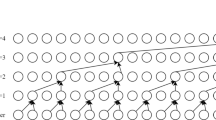Abstract
This paper studies the process of speaker identification over Bluetooth networks. Bluetooth channel degradations are considered prior to the speaker identification process. The work in this paper employs Mel-frequency cepstral coefficients for feature extraction. Features are extracted from different transforms of the received speech signals such as the discrete cosine transform (DCT), signal plus DCT, discrete sine transform (DST), signal plus DST, discrete wavelet transform (DWT), and signal plus DWT. A neural network classifier is used in the experiments, while the training phase uses clean speech signals and the testing phase uses degraded signals due to communication over the Bluetooth channel. A comparison is carried out between the different methods of feature extraction showing that the DCT achieves the highest recognition rates.












Similar content being viewed by others
References
Al Bawab, Z., et al. (2003). Speech recognition over bluetooth wireless channels. EUROSPEECH 2003, Geneva.
Chadha, A. (2011). Text-independent speaker recognition for low SNR environments with encryption. International Journal of Computer Applications, 31(10) (0975–8887), October 2011.
Chavan, M. S., & Chougule, S. V. (2012). Speaker features and recognition techniques: A review. International Journal of Computational Engineering Research. ISSN: 2250–3005, IJCER, May–June 2012, Vol. 2, Issue No. 3, 720–728.
El-Bendary, M. A. M. M. El-azm, A. E. A., El-Fishawy, N. A., Shawki, F., Abd-ElSamie, F. E., El-Tokhy, M. A. R., et al. (2012). Performance of the audio signals transmission over wireless networks with the channel interleaving considerations. EURASIP Journal on Audio, Speech, and Music Processing, 4.
Galushkin, A. I. (2007). Neural network theory. Berlin, Heidelberg: Springer.
Han, W. (2006). Speech recognition IC with an efficient MFCC features. The Chinese University of Hong Kong, Sept. 2006.
Haykin, S. (1999). Neural networks, 2nd ed. McMaster University, Hamilton, ON, Canada.
Kinnunen, T. (2003). Spectral Features for automatic text-independent speaker recognition. University of Joensuu, Department of Computer Science, Joenssuu, Finland.
Pullella, D., & Togneri, R. (2006). Speaker identification using higher order spectra. University of Western Australia.
Russo, M. (2005). Speech recognition over Bluetooth ACL and SCO links: A comparison. IEEE.
Shuling, L., & Wang, C. (2009) Nonspecific speech recognition method based on composite LVQ1 and LVQ2 network. Chinese Control and Decision Conference (CCDC), 2304–2388.
Trivedi, N., Kumar, V., Singh, S., Ahuja, S., & Chadha, R. (2011). Speech recognition by wavelet analysis. International Journal of Computer Applications, 15(8) (0975–8887) February 2011.
Author information
Authors and Affiliations
Corresponding author
Rights and permissions
About this article
Cite this article
Khalil, A.A., Elnaby, M.M.A., Saad, E.M. et al. Efficient speaker identification from speech transmitted over Bluetooth networks. Int J Speech Technol 17, 409–416 (2014). https://doi.org/10.1007/s10772-014-9238-4
Received:
Accepted:
Published:
Issue Date:
DOI: https://doi.org/10.1007/s10772-014-9238-4




